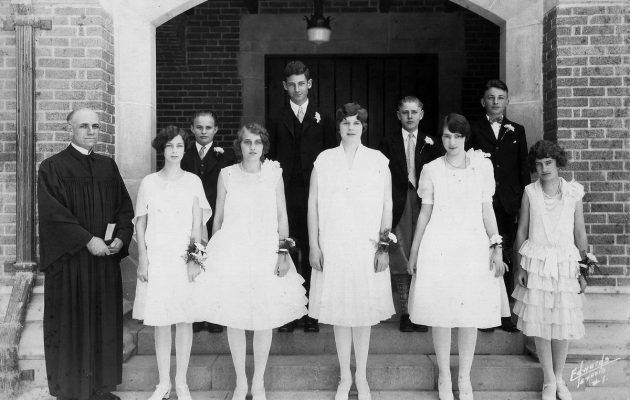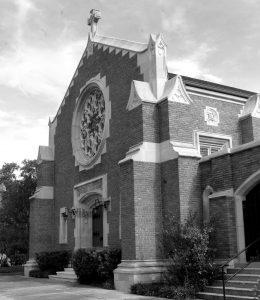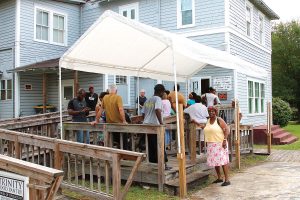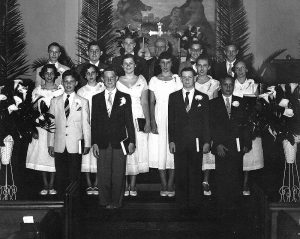Riverside church celebrates 90 years of Lutheran heritage

While not yet its centennial, nine decades of serving the Lord and the community is worthy of celebration for members of Trinity Lutheran Church in Riverside.
A 90th Anniversary 1926 Garden Party is planned for Sunday, Oct. 23 at the Ortega River Club, formerly the German-American Club, a long-time social gathering place for Trinity members.
During this anniversary year, Trinity members celebrated with choral performances, a service led by its children and youth and a Heritage Sunday service, an “eat-one, share-one [with Sulzbacher Center]” pie/dessert event, among other fun activities. A cookbook, commemorative poem, slogan and banner were also created to note the milestone.

An inscription over the front door of Trinity Lutheran Church reads “Ye Shall Know the Truth and the Truth Shall Make You Free.”
In the beginning
In 1926, as downtown Jacksonville grew and businesses began to surround St. John’s Lutheran Church, members living in Riverside decided to build a church closer to home, purchasing a lot at McDuff Avenue and Lydia Street for $15,375.
Trinity Lutheran Church was officially organized with the adoption of a Constitution and acceptance of the Charter of Incorporation which took place at a meeting of the congregation on October 3, 1926.
A small building, fondly called “The Hut” by the members, was constructed to serve the congregation until the current church and Sunday School building were completed and dedicated on Feb. 12, 1928. The cornerstone of the building includes a list of the members of the congregation, a Bible, Sunday school literature, and Luther’s catechism. The stone bears this inscription on its front surface: “The Trinity Lutheran Bible School.”
Many of the names of founding members are familiar ones in Jacksonville, such as Arpen, Braun, Holland, Lomax, Nease, Raabe and Witschen, of whom are named businesses, streets, and buildings. Of historical note, founding member Robert Kloeppel, Sr. spent $1.5 million to build the Hotel George Washington in 1926. In 1927, Trinity’s first annual banquet was held at the 15-story luxury hotel.
Anne Lomax Billy, 87, was baptized, confirmed and married at Trinity Lutheran Church and is the oldest church member from a charter family. Her mother, aunts and grand-parents were all charter members. Her brother, George, who passed away in 2007, is listed first in the parish baptismal register.
Anne’s husband, Bill Billy, tells the story about their courtship while he was serving in the Navy at NAS Jacksonville.
“Barbara Chapell tried to introduce me to Anne saying ‘I want you to meet this nice young man.’ I think Anne said she didn’t want to meet any nice young man. Little did she know. I learned about Luther League meeting on Sunday evening so I planned on going there,” said Billy. “Anyway, the next Sunday I was in front of church and Barbara brought Anne over and introduced her. I attended Luther League that night and the romance started. We were married by Pastor Pugh, Trinity’s first pastor, on April 7, 1953.”

The Trinity Food Pantry serves homeless and food-insufficient families in Riverside five days a week.
Building, not resting, on its laurels
Throughout its 90-year history Trinity’s congregation has kept up an almost constant program of expansion and improvement, including the acquisition of more property in the 1940s, construction in the 1950s and 1960s, and renovations from the 1980s through 2006, when the kitchen was remodeled.
Two of the most notable phases in the building programs included the Riechmann Educational Building, which was built at a cost of $53,182.35, and the Fellowship Hall and Recreational Annex. Named the “Hall of Memories,” this building was constructed in 1962 at a cost of $72,000.
The Hall of Memories, which can seat 600 in a meeting or serve 300 at a meal, has been used for church services and activities, community meetings, voting precincts, neighborhood and children’s outreach activities and miscellaneous sports activities.
The sanctuary has been home to three organs, beginning with the original Moeller Pipe Organ, which served the congregation for more than 40 years. During a 1966 remodeling, a Rodgers 440 Electronic Organ was installed in the new balcony, dedicated as a memorial to Ernest G. and Anna Fink Reinhold. In 2002, a new Allen Protégé Electronic Organ was placed near the chancel.
During the 1960s Trinity also purchased a two-story house on Park Street. At one time the second floor was used as living quarters for the various vicars who have interned at Trinity. The house also served previously as home to Lutheran Social Services of Northeast Florida’s mental health program and is currently used for the Trinity Food Pantry House.

The Confirmation Class of 1953 included Jonathan Ahrens, Marion Barz, Lawrence Beyer, Robert Brown, James Hawkins, Robye Kight, Patricia McClure, Elizabeth Meetze, Henry Newman, Jr., Fay Norma Rudue, Charles Richards, Donna Rowe, Roy Schnauss, Frederick Seiler, Jacqueline Thurm
Continuing to build on the generosity of its parishioners, new classrooms and meeting space were added in 1985, then in the early 1990s the church offices were remodeled and a colonnade was constructed to create covered entrances and to connect the sanctuary and the Hall of Memories. The memory garden, part of work completed in 1994, provides for a cinerarium used for the interment of ashes.
The sanctuary itself underwent renovations in 1995 when a wood and glass wall was added under the balcony to create a narthex at the entrance to the sanctuary. The apse and altar areas were remodeled to incorporate a new organ and a choir box at the front of the sanctuary. The foyer at the entrance to the office suite and Hall of Memories were remodeled to create a more functional and attractive area.
Even after 90 years, the congregation remains vibrant and open to all in the community.
“I see Trinity Lutheran as a welcoming people that looks to share God’s grace and love in worship and in the care for those in need throughout the community,” said Rev. Robert Kinley, who was called to be Trinity’s pastor in 2001 along with his wife, the Rev. Dr. Janis Kinley, who retired in 2012.
By Kate A. Hallock
Resident Community News






